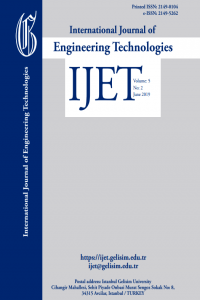Waste Glass “An Alternative of Cement and Fine Aggregate in Concreteˮ
Waste Glass “An Alternative of Cement and Fine Aggregate in Concreteˮ
Compressive strength, Waste management, Fine aggregate, Workability Concrete, Cement, waste glass powder,
___
- F. A. Olutoge and C. Strength, “Effect of Waste Glass Powder (WGP) on the Mechanical Properties of Concrete,” Am. J. Eng. Res., vol. 38, no. 511, pp. 2320–847, 2016, [Online]. Available: www.ajer.org.
- J. Cassar and J. Camilleri, “Utilisation of imploded glass in structural concrete,” Constr. Build. Mater., vol. 29, pp. 299–307, 2012, doi: 10.1016/j.conbuildmat.2011.10.005.
- A. M. Matos and J. Sousa-Coutinho, “Durability of mortar using waste glass powder as cement replacement,” Constr. Build. Mater., vol. 36, pp. 205–215, 2012, doi: 10.1016/j.conbuildmat.2012.04.027.
- P. K. Mehta, “Greening of the Concrete Industry for Sustainable Development,” Concr. Int., vol. 24, no. 7, pp. 23–28, 2002.
- T. Darshita and P. Anoop, “Study of Strength and Workability of Different Grades of Concrete by Partial Replacement of Fine Aggregate by Crushed Brick and Recycled Glass Powder,” vol. 3, no. 6, pp. 141–145, 2014.
- M. D. Lepech, V. C. Li, R. E. Robertson, and G. A. Keoleian, “40 Design of Green Ecc for Improved Sustainability,” no. 105, 2009.
- A. D. Neuwald, “Supplementary cementitious materials- part 1: pozzolanic SCMs,” MC Magezine, pp. 8–17, 2004.
- F. A. Olutoge, “Effect of Waste Glass Powder (WGP) on the Mechanical Properties of Concrete,” Am. J. Eng. Res., vol. 38, no. 511, pp. 2320–847, 2016, [Online]. Available: www.ajer.org.
- S. P. Gautam, V. Srivastava, and V. C. Agarwal, “Use of glass wastes as fine aggregate in Concrete,” J. Acad. Indus. Res, vol. 1, no. 6, p. 320, 2012.
- L. M. Federico and S. E. Chidiac, “Waste glass as a supplementary cementitious material in concrete - Critical review of treatment methods,” Cem. Concr. Compos., vol. 31, no. 8, pp. 606–610, 2009, doi: 10.1016/j.cemconcomp.2009.02.001.
- A. Pappu, M. Saxena, and S. R. Asolekar, “Solid wastes generation in India and their recycling potential in building materials,” Build. Environ., vol. 42, no. 6, pp. 2311–2320, 2007, doi: 10.1016/j.buildenv.2006.04.015.
- P. Turgut and E. S. Yahlizade, “Research into Concrete Blocks with Waste Glass,” Int. J. Civ. Environ. Eng., vol. 1, no. 4, pp. 203–209, 2009.
- Y. Jani and W. Hogland, “Waste glass in the production of cement and concrete - A review,” J. Environ. Chem. Eng., vol. 2, no. 3, pp. 1767–1775, 2014, doi: 10.1016/j.jece.2014.03.016.
- I. B. Topçu and M. Canbaz, “Properties of concrete containing waste glass,” Cem. Concr. Res., vol. 34, no. 2, pp. 267–274, 2004, doi: 10.1016/j.cemconres.2003.07.003.
- ISSN: 2149-0104
- Başlangıç: 2015
- Yayıncı: İstanbul Gelişim Üniversitesi
Nihad Abdulzahra Mezher MEZHER, Ahmad Reshad NOORI, Duygu ERTÜRKMEN
Waste Glass “An Alternative of Cement and Fine Aggregate in Concreteˮ
Muhammad Israr PASHTOON, Shafi Ullah MİAKHİL, Mohammad Mukhlis BEHSOODİ
Duygu YILDIRIM, Mukhallad Mohammed Mawlood AL-MASHHADANI
Proposed Framework for Daylight-Focused Homes during Design Development
Semih Göksel YILDIRIM, Stuart BAUR, Thomas G. YARBROUGH, Matthew NIETERS
